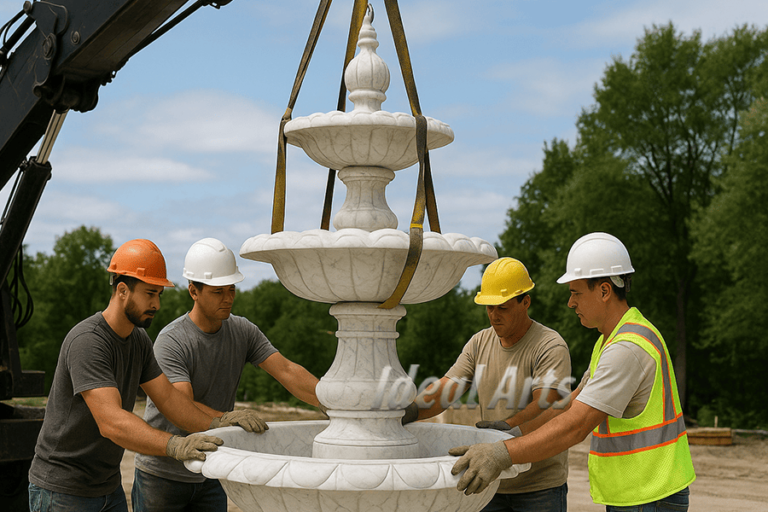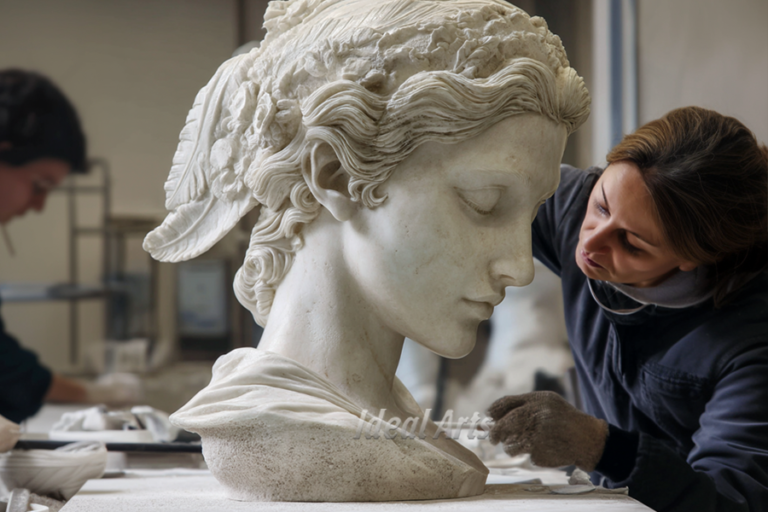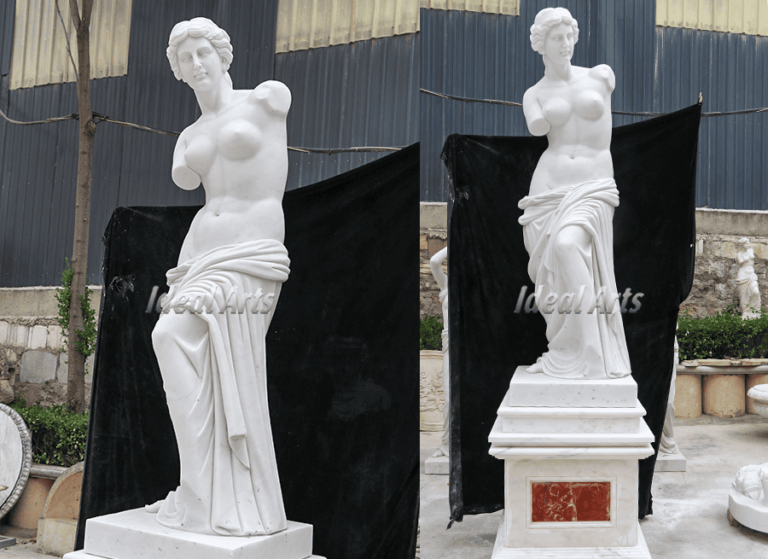The Statue of David by Michelangelo is one of the most iconic sculptures in history. It is more than just a figure made of marble. It represents the peak of Renaissance art, a symbol of human strength, and an emblem of the city of Florence. But why is this statue so famous? What makes it stand out among the countless works of art that have come before and after it?
I remember the first time I stood before David in Florence. The size, the detail, and the sheer presence of the figure left me speechless. But as I stood there, I started thinking—what exactly made David such a masterpiece? Was it just the technical brilliance of Michelangelo, or did it go beyond that? In this article, I’ll take you through the story behind this famous statue, its creation, and the reasons why it’s still a symbol of human achievement today.

1. What is the Story Behind the Statue of David?
The story behind David goes beyond its biblical origin. The narrative of its creation intertwines with the politics of Renaissance Florence, making it an emblem of civic pride and artistic genius.
The Statue of David represents the biblical hero who defeated Goliath, but Michelangelo’s interpretation of the story adds layers of symbolism and civic significance.
Transition ParagraphDavid’s biblical roots give the statue its dramatic foundation, but how does Michelangelo’s portrayal reshape this story? Let’s explore the deeper meaning behind the statue.
1.1 The Biblical and Cultural Origins of David
- David in the Bible: A shepherd boy who becomes the King of Israel by defeating the giant Goliath with a single stone.
- David as a Symbol of Virtue: In Renaissance Florence, David became a symbol of civic virtue, standing against tyranny, much like the Florentine Republic itself.
- David as the Archetype of Human Potential: Michelangelo’s David goes beyond the biblical hero—he represents the pinnacle of human achievement, intellect, and moral strength.
1.2 The Political and Civic Context of Renaissance Florence
- Florence in the Renaissance: The republic of Florence in the 16th century, striving for independence, found David to be the perfect symbol of defiance and strength.
- David as a Symbol of the Republic: Florence’s leaders saw in David not just a biblical hero but a political symbol representing the city-state’s fight for freedom.
1.3 The Commission of the Statue
- The Early History of the Commission: Initially commissioned for the Florence Cathedral, the statue was eventually placed in the Piazza della Signoria as a symbol of the city’s strength.
- The Controversy Surrounding the Statue: The decision to commission a marble statue, as opposed to bronze or other materials, reflected Michelangelo’s visionary approach and the city’s desire for something timeless.

2. How Was the Statue of David Created?
Michelangelo’s mastery of anatomy, his innovative techniques, and his understanding of human form made the creation of David an extraordinary feat of artistry. How did Michelangelo bring this vision to life?
Michelangelo spent over two years sculpting David from a single block of flawed marble, using groundbreaking techniques that would define Renaissance art for centuries.
Michelangelo’s approach to sculpture was radical for his time. Let’s look at the technical challenges he faced, and how he turned a flawed marble block into one of the most iconic works in art history.
2.1 Michelangelo’s Approach to Sculpture
- Anatomical Accuracy: Michelangelo was a master of human anatomy. His study of the human body allowed him to sculpt David with unparalleled precision, capturing muscles, veins, and posture with stunning realism.
- The Role of the Artist: In Renaissance Florence, the artist was seen not just as a craftsman, but as a genius. Michelangelo’s work on David helped elevate the status of artists in society.
2.2 The Selection of the Marble Block
- The Flawed Marble: The original marble block was large but considered flawed by earlier sculptors. Michelangelo saw potential where others saw imperfection, and he chose to work with it, transforming its perceived flaws into a unique challenge.
- The Sculpting Process: Over two years, Michelangelo meticulously chipped away at the marble, employing techniques like contrapposto (the balanced stance of the figure) and fine-tuning the details of the body.
2.3 The Challenge of Scale and Proportion
- Size and Scale: David stands at an impressive 17 feet tall. Creating a statue of this scale posed significant technical challenges, especially when it came to ensuring that proportions remained correct from head to toe.
- Contrapposto and Balance: The position of David—with one leg forward—displays a naturalistic posture known as contrapposto. This balance is critical to making the sculpture appear lifelike.

3. Why Does Michelangelo’s David Have Heart-Shaped Eyes?
The eyes of David have long been a subject of fascination. Michelangelo’s decision to depict them in a heart-shaped form carries symbolic weight. What does this detail reveal?
Michelangelo’s choice of heart-shaped eyes for David may symbolize his inner strength, divine protection, and a deeper connection to both human and spiritual courage.
While the eyes are a striking feature, their symbolism goes beyond aesthetics. Let’s explore the possible meanings behind this unique artistic choice.

3.1 The Symbolism of the Heart in Renaissance Art
- Renaissance Symbolism: In Renaissance art, the heart was often used to symbolize love, purity, and divine protection. By giving David heart-shaped eyes, Michelangelo may have been imbuing the statue with both human and divine qualities.
- The Eyes as a Reflection of the Soul: In Renaissance philosophy, the eyes were considered the windows to the soul. By exaggerating the shape of David’s eyes, Michelangelo may have been conveying a deeper message about the hero’s inner strength and moral clarity.
3.2 David’s Psychological State: Preparing for Battle
- David’s Expression: Unlike other depictions of David, which focus on his moment of victory, Michelangelo’s David captures the tense moment before the battle, suggesting that the heart-shaped eyes symbolize his mental focus, determination, and connection to divine will.
- An Allegory of Human Potential: Michelangelo’s David is often seen as an allegory for the potential within all of us to face and overcome challenges, with the heart-shaped eyes reflecting this inner strength and resolve.

4. Symbolism in David’s Design
David’s design is not just a display of artistic genius; every aspect is filled with symbolic meaning. What do the proportions, pose, and expression convey about human strength and potential?
The proportions of David, his pose, and facial expression each serve to symbolize not only physical strength but also the intellectual and moral clarity that made him a hero.
To fully appreciate David’s symbolism, we must understand how the artist blended the classical ideals of the human form with Renaissance humanism.
4.1 The Classical Influence
- The Classical Tradition: Michelangelo’s David draws heavily on the classical tradition, particularly the idealized human forms of ancient Greece and Rome. David’s body is sculpted to reflect these ideals of beauty, harmony, and balance.
- Contrapposto Pose: The contrapposto stance of David is derived from classical Greek statues, meant to reflect natural movement and human potential.
4.2 Renaissance Humanism
- Humanism and Individualism: The Renaissance celebrated the individual, and David embodies this spirit. He is not just a biblical hero but also a symbol of the power of human intellect, beauty, and potential.
- David as an Ideal of Renaissance Virtue: Michelangelo’s portrayal of David goes beyond the literal biblical story to symbolize the intellectual and moral strength that was valued during the Renaissance.

5. Why was the Statue of David originally placed in the Piazza della Signoria?
The Statue of David was originally intended for the Florence Cathedral, but the final placement was in the Piazza della Signoria, a public square in front of the Palazzo Vecchio. This location was chosen because the statue came to symbolize the strength and independence of the Florentine Republic. At the time, Florence was facing external threats, and placing David in the Piazza served as a powerful political statement. David represented Florence’s resilience, courage, and willingness to stand up to larger powers, much like the biblical David faced the giant Goliath.
The choice of location also allowed the public to admire the statue in all its grandeur. As Florence’s political and cultural heart, the Piazza was a fitting place for such an important symbol of civic pride. David, in this context, wasn’t just a religious figure but a symbol of the republic’s defiance against oppression.

6.Why does Michelangelo’s David have such an intense facial expression?
Michelangelo’s David is unique in that it depicts the moment before the battle with Goliath, when David is not yet victorious. Most representations of David show him after defeating Goliath, with a calm or triumphant expression. However, Michelangelo chose to capture a more intense moment—David is staring ahead, focused and determined, as if he is preparing for the battle of his life.
The facial expression reflects the psychological state of David as he faces his giant adversary. His furrowed brow and tight lips convey a sense of concentration and tension. This moment of heightened awareness, full of potential energy, is characteristic of Renaissance humanism. It reflects the idea that true greatness comes not just from physical prowess, but from mental and emotional fortitude. Michelangelo’s David is not just a hero of strength, but also of willpower, intellect, and courage.

7. Why is David depicted without armor or weapons?
Unlike many classical depictions of David, Michelangelo’s sculpture shows him without armor or any weapon except for a slingshot slung over his shoulder. This choice is highly significant, as it underscores David’s reliance not on physical strength or weaponry, but on his inner strength, faith, and intelligence.
The absence of armor also sets Michelangelo’s David apart from earlier portrayals of warriors, emphasizing the idea that true power comes from within, not from external protection. In Renaissance Florence, where intellectual and moral strength were highly valued, Michelangelo’s decision to depict David in this vulnerable yet powerful way aligned with the ideals of humanism. David’s victory over Goliath wasn’t just about defeating a physical enemy; it was a victory of mind over matter.

8. Why does David’s right hand look larger than the left?
One of the distinctive features of Michelangelo’s David is the disproportionate size of his right hand, which appears much larger than the left. This wasn’t a mistake but a deliberate artistic choice. There are several theories about why Michelangelo made this decision.
Some art historians believe that the oversized right hand symbolizes David’s strength and readiness for battle. David’s right hand is poised to wield the sling that will defeat Goliath, so its larger size may represent the power and determination in his forthcoming action.
Another explanation ties into Renaissance artistic conventions. In many classical and Renaissance sculptures, the hands and feet were often exaggerated to draw attention to certain qualities, such as strength or dexterity. The right hand, being the active hand in the battle, was emphasized to underscore the idea that David’s victory over Goliath would come through strength, both physical and mental.

9. Why is David considered a symbol of Florence?
David became a symbol of Florence because of the political and cultural context in which Michelangelo’s statue was created. During the early 1500s, Florence was an independent republic facing significant external threats, particularly from the powerful Medici family and other rival states. The citizens of Florence saw themselves as an underdog, much like the biblical David who defeated the giant Goliath with little more than a sling and a stone.
The statue of David was placed in the Piazza della Signoria, the political heart of Florence, as a symbol of the city’s determination and resilience. It represented the Florentines’ belief that, like David, they could overcome even the most powerful adversaries. Over time, the statue became an emblem of Florence’s civic pride and its commitment to ideals such as freedom, independence, and intellectual achievement.
10. Is Michelangelo’s David the only statue of this subject?
Michelangelo’s David is the most famous, but it is not the only depiction of the biblical hero. The theme of David was popular among Renaissance artists, with multiple sculptures, paintings, and even architectural elements dedicated to this subject. Some notable examples include:
- Donatello’s David: This bronze statue, created in the 1440s, is considered one of the first significant Renaissance depictions of David. It shows a young and slightly sensuous David, standing triumphantly over the head of Goliath.
- Verrocchio’s David: Another Renaissance bronze, created by Andrea del Verrocchio in the 1470s, portrays David with a more traditional warrior stance, holding a sword.
- Bernini’s David: In the Baroque period, sculptor Gian Lorenzo Bernini created another famous statue of David. Unlike Michelangelo’s, which shows David in a calm, contemplative moment, Bernini’s depicts the action-packed moment of the battle with Goliath, emphasizing movement and drama.
Despite these other depictions, Michelangelo’s David remains the most iconic, largely due to its size, detail, and emotional intensity.
Comparison: David vs. Other Renaissance Sculptures
| Feature | Michelangelo’s David | Donatello’s David | Bernini’s David |
|---|---|---|---|
| Material | Marble | Bronze | Marble |
| Pose | Contrapposto, tense | Relaxed, youthful | Dramatic, action-focused |
| Expression | Intense, focused | Calm, playful | Violent, full of motion |
| Significance | Embodies human potential | First life-sized David | Dynamic, action-packed |

Conclusion
In the end, Michelangelo’s David is not just a work of art; it’s a symbol of everything the Renaissance stood for—human strength, intellectual achievement, and moral courage. It’s no wonder that after more than 500 years, the statue still captures the imagination of people from all over the world.
As I reflect on David’s story, I can’t help but think about what it represents for all of us. Whether we’re facing our own Goliaths or simply striving for personal greatness, David is a reminder that we have the strength and potential to achieve the impossible.





